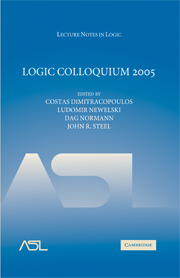Book contents
- Frontmatter
- Contents
- Introduction
- Speakers and Titles
- Thread algebra and risk assessment services
- Covering definable manifolds by open definable subsets
- Isomorphisms and definable relations on computable models
- Independence for types in algebraically closed valued fields
- Simple groups of finite Morley rank
- Towards a logic of type-free modality and truth
- Structural analysis of Aronszajn trees
- Proof analysis in non-classical logics
- Paul Bernays' later philosophy of mathematics
- Proofnets for S5: Sequents and circuits for modal logic
- Recursion on the partial continuous functionals
- A transactional approach to the logic of truth
- On some problems in computable topology
- Monotone inductive definitions and consistency of New Foundations
- LECTURE NOTES IN LOGIC
Simple groups of finite Morley rank
Published online by Cambridge University Press: 18 December 2009
- Frontmatter
- Contents
- Introduction
- Speakers and Titles
- Thread algebra and risk assessment services
- Covering definable manifolds by open definable subsets
- Isomorphisms and definable relations on computable models
- Independence for types in algebraically closed valued fields
- Simple groups of finite Morley rank
- Towards a logic of type-free modality and truth
- Structural analysis of Aronszajn trees
- Proof analysis in non-classical logics
- Paul Bernays' later philosophy of mathematics
- Proofnets for S5: Sequents and circuits for modal logic
- Recursion on the partial continuous functionals
- A transactional approach to the logic of truth
- On some problems in computable topology
- Monotone inductive definitions and consistency of New Foundations
- LECTURE NOTES IN LOGIC
Summary
Historical motivations. Modern model theory started when M. Morley [Mor65] proved his famous theorem on the categoricity in any uncountable cardinal of first order theories categorical in one uncountable cardinal. He introduced for that purpose an ordinal valued rank on types of such a theory, later shown to be finite by J. Baldwin [Bal73].
fact 1.1. An uncountably categorical first order theory has finite Morley rank.
This was the begining of the fantastic development of the classification theory by S. Shelah on the number of non-isomorphic uncountable models of a first order theory [She90], and more precisely the developments of stability theory with all subsequent generalizations of linear or algebraic independance in classical mathematical structures such as vector spaces or fields. In the meantime, it appeared interesting to study structures with such a given model-theoretic property. The first result of this kind was obtained by A. Macintyre [Mac71].
macintyre's theorem.An infinite field of finite Morley rank is algebraically closed.
On the other hand, B. Zilber showed in his work on uncountably categorical structures the following result on simple groups of finite Morley rank [Zil77].
fact 1.2. An infinite simple group of finite Morley rank is uncountably categorical.
Naturally, this result gave the feeling that simplicity was certainly hiding stronger structural properties. Hence, motivated by a sense that most structures already exist “in nature”, G. Cherlin and B. Zilber proposed independently the following conjecture in the late seventies.
- Type
- Chapter
- Information
- Logic Colloquium 2005 , pp. 57 - 67Publisher: Cambridge University PressPrint publication year: 2007
- 1
- Cited by

